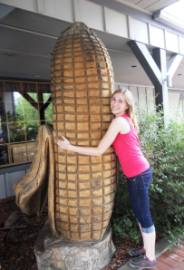I hope that you’ve enjoyed the last three posts about corn and learned at least one thing. 🙂 This last part is all about talking through some common myths and questions about the corn industry.
High fructose corn syrup is bad for you and causes obesity.
This statement is kinda true, yet mostly false. High Fructose Corn Syrup (HFCS) is no different than your table sugar, other than that it is commonly found in a liquid form instead of crystalized. The only difference is that is contains slightly more fructose than glucose molecules, while table sugar breaks down into a 50/50 split. Because the compositions are so similar, your body will digest the sugars the same way.
Did you know that the table sugar you are familiar with comes from either sugarcane or sugarbeets? The main reason that HFCS has become popular in the food industry is because it is cheaper than sugarcane or sugarbeet sugar. The United States also has really high tariffs on imported sugar in order to protect the domestic sugarcane/sugarbeet sugar industry, so importing cheaper sugar isn’t really an option.
Finally, high fructose corn syrup is not bad for you, just as cane and beet sugar is not. However, many people blame HFCS on the obesity epidemic. This is not the corn industry’s fault. What the problem really comes down to is lifestyle choices of Americans. If we choose to eat lots of pre-packaged snacks and drink lots of pop instead of choosing fruits, vegetables, and milk, that is our own fault. Obesity is caused by not making good food choices, as well as consuming more calories than our bodies can burn. All in all, HFCS and sugar are not bad for you, but if you consume large quantities of either of these types of sugar it can lead to weight gain. So make good food choices: be sure to eat from all of the food groups and follow serving size suggestions. 🙂
Ethanol is using up corn that we could be eating.
False. We can only eat so much corn, and then we still have leftovers! Actually, the corn that we are used to eating is sweet corn, which is grown only to eat. Ethanol is made out of field corn (check out any of the previous corn blog posts for more information about field corn vs. sweet corn). We use field corn for many things: feeding livestock, making ethanol, producing foods, and making different industrial goods. After all of that, we still have enough leftover to export to other countries. If it ever came down to choosing between producing ethanol and feeding people, ethanol production would cease and resources would be devoted to making food. The number one priority in agriculture is to feed people. Having the opportunity to make a renewable fuel is a bonus since agriculture has been so successful in producing enough food to feed America.
In addition, technology is advancing in the ethanol industry. This means that we are learning how to utilize other resources to make fuel, such as using grasses or agricultural waste (manure or old corn stalks). In the future, we probably won’t see as much ethanol made from the corn kernel, but we will continue to see ethanol as a renewable fuel option.
Farmers are producing too much corn and not enough food.
As I discussed in my post Keeping it Local, the Midwest is well-suited to grow corn because of optimal soil fertility, rainfall, and temperatures during the growing season. While we can grow pretty much any kind of food here in Central Illinois, we are better contributing to the nationwide food supply by growing corn. We consume corn products in different foods found at the grocery store, eat meat that was fed at least some corn at some point, among other things. But because other parts of the United States aren’t as awesome at growing corn as we are here in the Midwest, that’s what we focus on while other regions grow our fruits, vegetables, grains (other than corn), and raise our meat. It just works out better in the end. If we stopped growing corn in Illinois and instead used the land to grow all of the food that we eat, we would have to plan ahead for winter since there would be very little, if any, produce on grocery store shelves. And what would livestock ranchers out West do without our corn? They could feed other grasses and grains to their animals, but livestock LOVE corn, not to mention the amount of additional land that would be needed to produce enough hay to feed the livestock.
As long as there is a market for the amount of corn produced in the United States, farmers will continue to grow it. When they are unable to sell it, they will pursue other options. Farmers don’t just grow whatever they want. They are business owners, too. They are going to grow a product that they can sell. Since corn is such a versatile crop there is lots of demand for it, therefore lots of farmers grow it.
Have more questions? Tweet me @iheartag14 or comment below! I’d like to hear what you think, whether you agree or disagree. This blog is all about making agriculture make sense for you.


No Comments